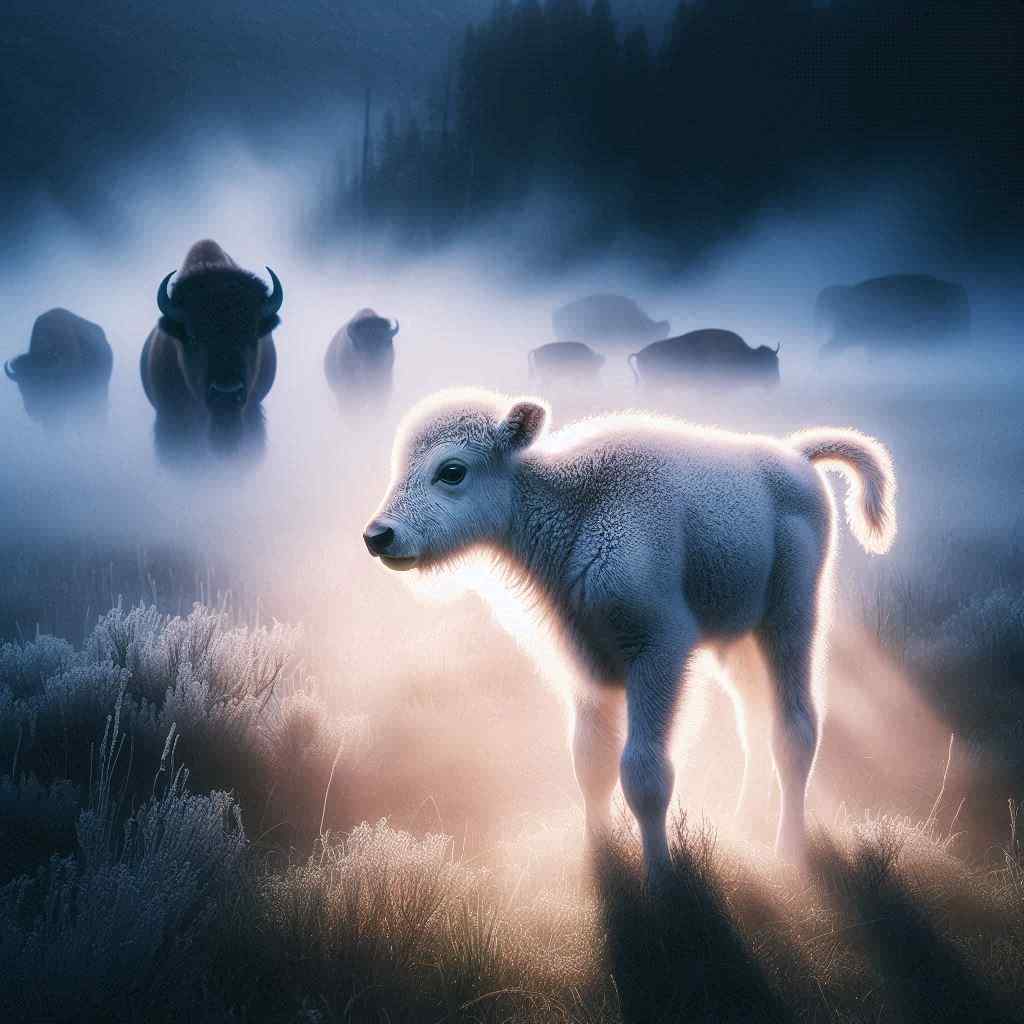Song of the White Calf
Richard

The white buffalo calf has arrived
A sacred omen, a sign from above
The herd in Yellowstone, the last of its kind
Brings hope for the future, a blessing of love
Oh Great Spirit, hear our song
Guide us to restore what was lost for so long
The buffalo roam, the people rejoice
The white calf returns, we raise up our voice
For centuries the tribes have passed down
The story of the White Buffalo Woman
She came in a time of great need, with gifts all around
To show the people how to live, how to pray, how to grow
The herds were decimated, the people suffered too
But now a new chapter, a chance to renew
The land, the culture, the bond that was broke
As the white calf stands tall, a powerful provoke
The white buffalo calf, a sacred sight
A beacon of hope, a future so bright
For the Yellowstone herd, the last of its kind
May the Great Spirit's blessings forever be entwined.
Richard's Song of the White Calf
The original song "Song of the White Calf" is a poignant and powerful reflection on the cultural and spiritual significance of the white buffalo calf, particularly within Native American traditions. The lyrics weave together historical context, spiritual beliefs, and contemporary conservation efforts, creating a multi-layered narrative that resonates on several levels.
The opening verse immediately establishes the central theme: the arrival of a white buffalo calf as a sacred omen. This corresponds directly with the real-life event of a white bison calf born in Yellowstone National Park, as described in the news article. By connecting this rare occurrence to ancient prophecies and beliefs, the song bridges past and present, emphasizing the enduring importance of these traditions.
The recurring chorus, "Oh Great Spirit, hear our song / Guide us to restore what was lost for so long," serves as both a prayer and a call to action. It acknowledges the spiritual dimension of the event while also highlighting the ongoing efforts to revitalize both bison populations and Native American cultural practices. This duality is a key strength of the song, as it intertwines ecological conservation with cultural preservation.
The second verse introduces the legend of the White Buffalo Woman, a crucial element of Lakota, Dakota, and Nakoda spiritual traditions. By incorporating this story, the song provides context for why the birth of a white buffalo calf is considered so significant. It also subtly draws parallels between the woman's gifts of sacred teachings and the contemporary hope for renewal that the calf represents.
In the third verse, the lyrics touch on the historical trauma experienced by both the buffalo and Native American peoples. The line "The herds were decimated, the people suffered too" succinctly captures the intertwined fates of the bison and indigenous communities. This historical acknowledgment gives weight to the subsequent message of hope and renewal.
The final verse brings the narrative full circle, returning to the present-day significance of the white calf. The phrase "a beacon of hope, a future so bright" encapsulates the optimism that this event has inspired among conservationists and tribal communities alike. By ending with a reference to the Yellowstone herd as "the last of its kind," the song reminds listeners of the precarious state of wild bison populations and the importance of ongoing conservation efforts.
Throughout the song, the use of repetition in the chorus and the consistent rhyme scheme create a sense of ritual and continuity, mirroring the cyclical nature of the prophecies and the enduring strength of Native American spiritual traditions.
The metaphors employed in the lyrics are particularly effective. The white calf itself serves as a metaphor for hope, renewal, and the interconnectedness of all things. The reference to the calf standing tall as a "powerful provoke" suggests that this event is not just a passive sign, but a call to action for both conservation and cultural revitalization.
In essence, "Song of the White Calf" is a lyrical exploration of hope emerging from adversity, the cyclical nature of spiritual beliefs, and the deep connections between cultural heritage and environmental stewardship. It captures the complexity of the situation – celebrating a moment of joy and spiritual significance while also acknowledging the challenges that remain in fully restoring bison populations and Native American cultural practices.
This text was generated by AI and is for reference only. Learn more
Want to join the discussion? Reopen or create a unique username to comment. No personal details required!



Comments
No comments yet. Be the first to comment!